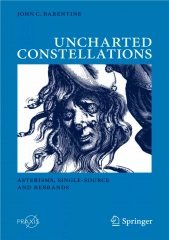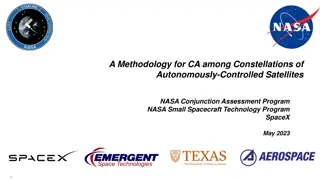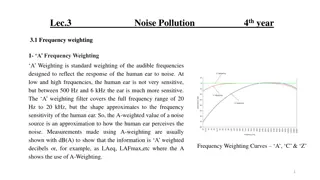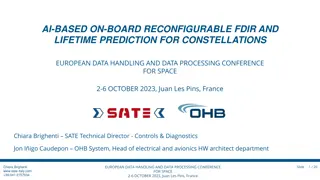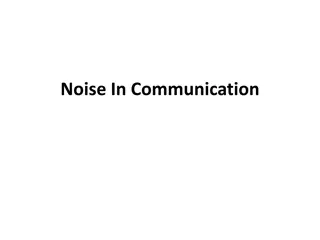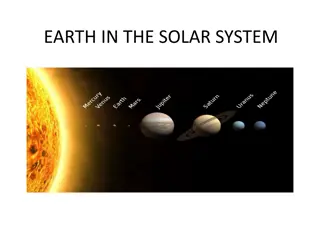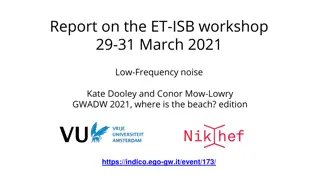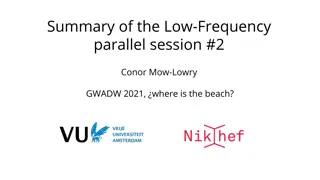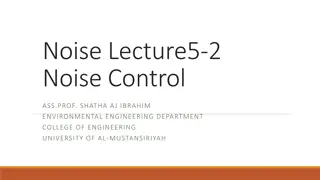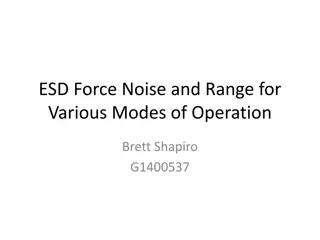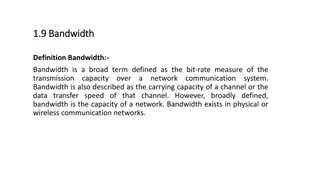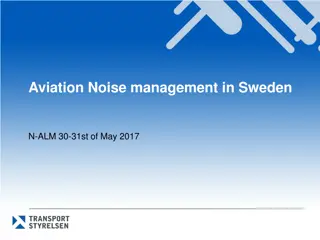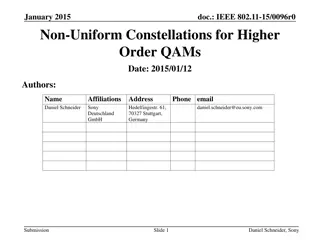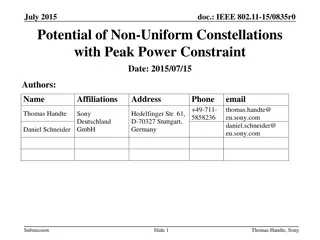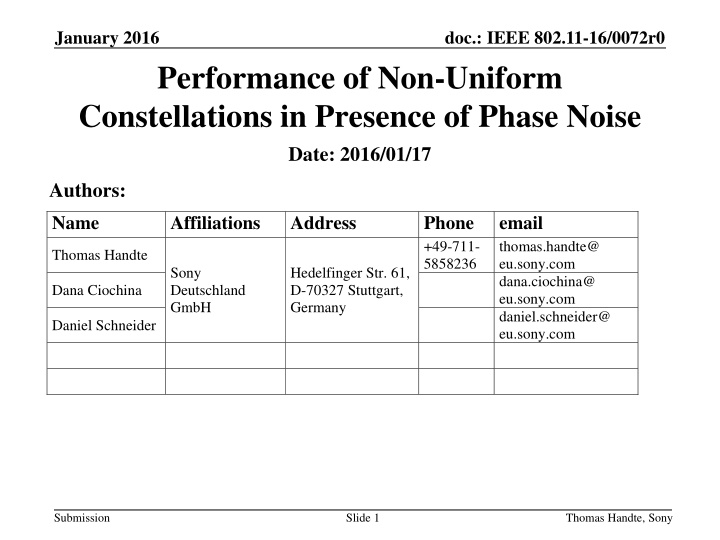
Performance of Non-Uniform Constellations in the Presence of Phase Noise
Explore the robustness and potential advantages of non-uniform constellations (NUCs) in single-carrier modulation under phase noise conditions. Gain insights into how NUCs with 64 signal points provide improved performance compared to uniform constellations (UCs) while maintaining demapping complexity. Discover the optimization strategies and benefits of NUCs in SC transmission for enhancing communication efficiency.
Download Presentation

Please find below an Image/Link to download the presentation.
The content on the website is provided AS IS for your information and personal use only. It may not be sold, licensed, or shared on other websites without obtaining consent from the author. If you encounter any issues during the download, it is possible that the publisher has removed the file from their server.
You are allowed to download the files provided on this website for personal or commercial use, subject to the condition that they are used lawfully. All files are the property of their respective owners.
The content on the website is provided AS IS for your information and personal use only. It may not be sold, licensed, or shared on other websites without obtaining consent from the author.
E N D
Presentation Transcript
January 2016 doc.: IEEE 802.11-16/0072r0 Performance of Non-Uniform Constellations in Presence of Phase Noise Date: 2016/01/17 Authors: Name Affiliations Address Phone +49-711- 5858236 email thomas.handte@ eu.sony.com dana.ciochina@ eu.sony.com daniel.schneider@ eu.sony.com Thomas Handte Sony Deutschland GmbH Hedelfinger Str. 61, D-70327 Stuttgart, Germany Dana Ciochina Daniel Schneider Submission Slide 1 Thomas Handte, Sony
January 2016 doc.: IEEE 802.11-16/0072r0 Abstract This contribution outlines The performance of non-uniform constellations (NUCs) in single- carrier (SC) modulation under influence of phase noise NUCs of [1] with 64 signal points are considered NUCs are shown to be robust against phase noise The gain compared to uniform constellations (UCs) is even increased Comparison of demapping complexity NUC definition Signal points and bit labelling Submission Slide 2 Thomas Handte, Sony
January 2016 doc.: IEEE 802.11-16/0072r0 Motivation Higher order QAMs discussed in e.g. [2-4] as a potential technology for 802.11ay SC: 64-QAM (up to 16-QAM in ad) Non-uniform constellations performance compared to uniform constellations (UCs) NUCs provide shaping gain [5, 6] improved robustness against impairments [7] such as ADC quantization fading channels a lower peak power than UCs, e.g. [1] a moderate increase in demapper complexity See later (NUCs) provide increased Submission Slide 3 Thomas Handte, Sony
January 2016 doc.: IEEE 802.11-16/0072r0 Introduction So far, the effect of phase noise on the performance of NUCs has been investigated for OFDM only Investigations [7] show that NUCs can maintain or even improve their gain in presence of phase noise, quantization, or fading. In this contribution, we investigate the performance of NUCs in SC transmission NUCs for SC can be optimized in various ways [1] Here we present performance results of NUCs with Zero shaping gain but minimum PAPR: Cat. B Maximum shaping gain and unconstraint PAPR: Cat. D Submission Slide 4 Thomas Handte, Sony
January 2016 doc.: IEEE 802.11-16/0072r0 Introduction (cont.) NUC performance in SC communications The overall gain has two sources A. Shaping gain NUCs require less SNR than UCs for same FER B. Peak power gain NUCs have a lower PAPR than UCs Shaping gain and peak power gain are not independent Optimization targets Cat. D +0.35 dB +0.35 dB NUC Cat. Shaping gain PAPR gain Cat. B UC B max 0 + 1.3 dB D Max unconstraint Submission Slide 5 Thomas Handte, Sony
January 2016 doc.: IEEE 802.11-16/0072r0 Simulation Parameters Focus on constellations with 64 signal points .11ad LDPC with code rates (CR): 1/2, 5/8, 3/4, 13/16 SC modulation Message length: 1000 bytes Channel model AWGN Phase noise at transmitter and receiver Spectral noise mask according to evaluation methodology [9] Receiver Regular approx. LLR demapper Phase noise mitigation Analysis Performance compared at FER = 10-2 Benchmark Regular uniform 64-QAM Submission Slide 6 Thomas Handte, Sony
January 2016 doc.: IEEE 802.11-16/0072r0 Results FER performance w/o and w/ phase noise NUCs offer a shaping gain depending on Cat. and CR NUC requires less SNR than UC for same FER Cat. B and UC have approx. same performance shaping gain 0 dB Cat. D has a SNR gain compared to UC shaping gain up to 0.4 dB Phase noise yields degradation UC and NUC are similarly influenced CR1/2 CR5/8 Submission Slide 7 Thomas Handte, Sony
January 2016 doc.: IEEE 802.11-16/0072r0 Results (cont.) NUC shaping gain w/o and w/ phase noise as a function of CR Shaping gain is even further increased in presence of phase noise i.e. NUCs are more robust than UC Shaping gain increases up to 0.9 / 1.1 dB for Cat. B / Cat. D with phase noise Additional gain of 0.9 / 0.8 dB Cat. B Cat. D Submission Slide 8 Thomas Handte, Sony
January 2016 doc.: IEEE 802.11-16/0072r0 Results (cont.) Overall NUC gain w/o and w/ phase noise Summation of shaping gain and peak power gain Shaping gain increases in presence of phase noise Peak power gain is unchanged Overall gain up to 1.5 / 2.1dB (w/o PN / w/ PN) compared to regular UC Cat. B Cat. B Cat. D Cat. D Submission Slide 9 Thomas Handte, Sony
January 2016 doc.: IEEE 802.11-16/0072r0 On the Demapper Complexity Simple analysis of demapper complexity Actual complexity depends on implementation Focus here on basic approx. LLR demapper w/o sphere detection or similar techniques Computation of LLR values based on metric ? ?2, r: received, s: transmitted symbol Regular UC Demapping of real and imaginary part can be separated M-QAM can be decomposed into two ?-PAM LLR values can be retrieved after 2 ? metric computations 2D-NUC Joint demapping of real and imaginary part required LLR values can be retrieved after Additional demapping complexity scales with ? 2D-NUC requires e.g. 3-fold for ? = 64 However techniques are known which reduce decoding complexity for 2D-NUCs further [10] existing standards (ATSC 3.0 / DVB-S2x) go up to ? = 256 2D-NUCs overall decoder complexity still dominated by LDPC decoder 4? metric computations 3 3 ? 8-fold metric computations Submission Slide 10 Thomas Handte, Sony
January 2016 doc.: IEEE 802.11-16/0072r0 Conclusion Investigation of NUC performance in presence of phase noise Low CRs: NUC gain is at least maintained High CRs: Additional NUC gain NUCs are a promising technology for .11ay Significant performance gains up to 1.6dB w/o PN up to 2.1dB w/ PN Robust against phase noise, quantization [7] in fading channels [7] Only a moderate complexity increase Submission Slide 11 Thomas Handte, Sony
January 2016 doc.: IEEE 802.11-16/0072r0 References 1. 11-15-0835-01-00ay Potential of Non-Uniform Constellations with Peak Power Constraint 11-14-1378-00-ng60 PHY rate for NG60 11-14-0652-01-0wng-wng Next Generation 802.11ad 11-15-0339-00-ng60 SC-64APSK for 11ay 11-15-0096-01-ng60 Non-uniform Constellations for higher Order QAMs 11-15-0601-00-00ay Non-uniform Constellations for 64QAM 11-15-1290-00-00ay Effect of Impairments on the Performance of Non-Uniform Constellations 11-15-1289-00-00ax Non-Uniform Constellations for 1024-QAM 11-15-0866-01-00ay 11ay evaluation methodology 10. M. Fuentes, D. Vargas, and D. G mez-Barquero Low-Complexity Demapping Algorithm for Two-Dimensional Non-Uniform Constellations , IEEE Trans. on Broadcasting, Nov. 2015 2. 3. 4. 5. 6. 7. 8. 9. Submission Slide 12 Thomas Handte, Sony
January 2016 doc.: IEEE 802.11-16/0072r0 APPENDIX Submission Slide 13 Thomas Handte, Sony
January 2016 doc.: IEEE 802.11-16/0072r0 NUC definition for 64-QAM Each CR requires a dedicated NUC for maximum gain All NUCs feature quadrant symmetry 64-QAM 2D-NUCs can be deduced from 16 signal points Those signal points reside in the 1st quadrant (Re>0, Im>0) define 4 bit of the mapping Binary reflected Gray mapping yields all other signal points All quadrants define further 2 bit of the mapping Example: 16-QAM 2D-NUC deduced from 4 signal points Reflect on axis 10 00 11 01 Submission Slide 14 Thomas Handte, Sony
January 2016 doc.: IEEE 802.11-16/0072r0 NUC definition for Cat. B CR 1/2 CR 5/8 CR 3/4 CR 13/16 bit label (dec/bin) constell. point 0 0000 1 0001 2 0010 3 0011 4 0100 5 0101 6 0110 7 0111 8 1000 9 1001 10 1010 11 1011 12 1100 13 1101 14 1110 15 1111 bit label (dec/bin) 0 0000 1 0001 2 0010 3 0011 4 0100 5 0101 6 0110 7 0111 8 1000 9 1001 10 1010 11 1011 12 1100 13 1101 14 1110 15 1111 constell. point 0.9699+0.8872i 1.1373+0.6592i 0.7267+1.0953i 0.6674+0.7288i 1.0576+0.1697i 1.2827+0.2806i 0.7556+0.1489i 0.6848+0.4274i 0.1232+1.3068i 0.1033+0.8328i 0.4127+1.2480i 0.3677+0.7975i 0.1397+0.1351i 0.1271+0.4424i 0.4277+0.1188i 0.3985+0.4387i bit label (dec/bin) 0 0000 1 0001 2 0010 3 0011 4 0100 5 0101 6 0110 7 0111 8 1000 9 1001 10 1010 11 1011 12 1100 13 1101 14 1110 15 1111 constell. point 0.6500+1.1646i 0.9310+0.9553i 0.2805+1.3043i 0.7368+0.7378i 1.3105+0.2510i 1.1734+0.6352i 0.9456+0.1845i 0.8822+0.4713i 0.1685+0.8848i 0.1966+0.6221i 0.3217+0.9867i 0.4946+0.6715i 0.2121+0.1514i 0.2068+0.3870i 0.5775+0.1615i 0.5450+0.3989i bit label (dec/bin) constell. point 0 0000 1 0001 2 0010 3 0011 4 0100 5 0101 6 0110 7 0111 8 1000 9 1001 10 1010 11 1011 12 1100 13 1101 14 1110 15 1111 0.8720+0.9586i 1.0576+0.7490i 0.7219+1.0761i 0.6925+0.6896i 1.2799+0.2034i 1.2243+0.4205i 0.7746+0.1646i 0.7521+0.3483i 0.2219+1.2768i 0.1677+0.7632i 0.3634+1.2439i 0.3288+0.7437i 0.1600+0.1553i 0.1605+0.3899i 0.4000+0.1565i 0.3857+0.3824i 0.9803+0.5083i 0.1784+0.4952i 0.7466+0.4990i 0.4731+0.4933i 1.0552+0.1989i 0.1792+0.1858i 0.7646+0.1841i 0.4773+0.1847i 1.1117+0.7365i 0.1835+0.7954i 0.7344+0.8717i 0.4736+0.7895i 1.3053+0.2730i 0.1983+1.0792i 0.6962+1.1374i 0.2923+1.3011i Submission Slide 15 Thomas Handte, Sony
January 2016 doc.: IEEE 802.11-16/0072r0 NUC definition for Cat. D CR 1/2 CR 5/8 CR 3/4 CR 13/16 bit label (dec/bin) constell. point 0 0000 1 0001 2 0010 3 0011 4 0100 5 0101 6 0110 7 0111 8 1000 9 1001 10 1010 11 1011 12 1100 13 1101 14 1110 15 1111 bit label (dec/bin) 0 0000 1 0001 2 0010 3 0011 4 0100 5 0101 6 0110 7 0111 8 1000 9 1001 10 1010 11 1011 12 1100 13 1101 14 1110 15 1111 constell. point 0.2775+1.4188i 0.7921+1.2096i 0.2177+1.0243i 0.6056+0.8481i 1.4730+0.3019i 1.2124+0.8333i 1.0895+0.2172i 0.8988+0.5768i 0.1138+0.3999i 0.2891+0.3910i 0.1487+0.7260i 0.4397+0.5853i 0.1419+0.1122i 0.3733+0.1498i 0.7863+0.1337i 0.6394+0.3211i bit label (dec/bin) 0 0000 1 0001 2 0010 3 0011 4 0100 5 0101 6 0110 7 0111 8 1000 9 1001 10 1010 11 1011 12 1100 13 1101 14 1110 15 1111 constell. point 1.0725+0.5328i 0.1361+0.4023i 0.7267+0.4592i 0.4198+0.4151i 1.0501+0.1676i 0.1398+0.1309i 0.7233+0.1496i 0.4246+0.1370i 1.0771+0.9315i 0.1373+0.7043i 0.6956+0.8095i 0.4114+0.7109i 1.4380+0.2294i 0.1680+1.0338i 0.6220+1.1896i 0.2326+1.3986i bit label (dec/bin) constell. point 0 0000 1 0001 2 0010 3 0011 4 0100 5 0101 6 0110 7 0111 8 1000 9 1001 10 1010 11 1011 12 1100 13 1101 14 1110 15 1111 0.2920+1.4732i 0.8348+1.2487i 0.2071+1.0283i 0.5811+0.8760i 1.4732+0.2920i 1.2487+0.8348i 1.0283+0.2071i 0.8760+0.5811i 0.1393+0.3138i 0.1671+0.3094i 0.1720+0.7004i 0.3741+0.6174i 0.3138+0.1393i 0.3094+0.1671i 0.7004+0.1720i 0.6174+0.3741i 1.0997+0.5419i 0.1440+0.4167i 0.7484+0.4663i 0.4369+0.4317i 1.0414+0.1712i 0.1414+0.1379i 0.7230+0.1517i 0.4272+0.1421i 1.0691+0.9443i 0.1426+0.7102i 0.7360+0.8042i 0.4351+0.7394i 1.4058+0.2115i 0.1695+1.0298i 0.5981+1.1597i 0.2236+1.3784i Submission Slide 16 Thomas Handte, Sony
January 2016 doc.: IEEE 802.11-16/0072r0 Visualization: NUCs Cat. B CR=1/2 CR=5/8 CR=13/16 CR=3/4 Submission Slide 17 Thomas Handte, Sony
January 2016 doc.: IEEE 802.11-16/0072r0 Visualization: NUCs Cat. D CR=1/2 CR=5/8 CR=13/16 CR=3/4 Submission Slide 18 Thomas Handte, Sony

